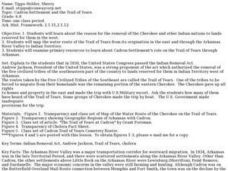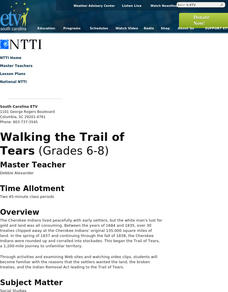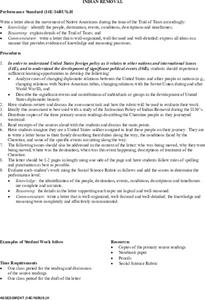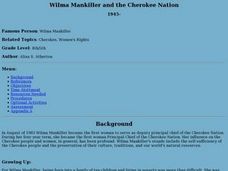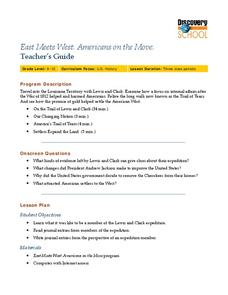K20 LEARN
Many Trails of Tears: The Era of Indian Removal
Cherokee, Chickasaw, Choctaw, Creek, and Seminole. All were forced off their ancestral lands in the southeastern United States as part of the Indian Removal Act of 1830. Young historians research the tribes' reactions to this removal and...
Curated OER
Cherokee Indians and the Trail of Tears
Students investigate U.S. history by reading American Indian stories. In this Cherokee Indian lesson plan, students identify the cruelty inflicted towards Native Americans by the European settlers and the "trail of tears" that were left....
Curated OER
Cadron Settlement and the Trail of Tears
Students examine the reason for removal of the Cherokee and other Indian nations. They map the water route of the Trail of Tears from its origination in the east and through the Arkansas River Valley to Indian Territory.
Curated OER
Walking the Trail of Tears
Students, through the use of examining video clips and Websites, become familiar with the reasons that the settlers wanted the land, broke treaties, and initiated the Indian Removal Act leading to the Trail of Tears.
Curated OER
The Cherokee: Trail Where They Cried
Students read the Trail of Tears about the Cherokee Nation removal and write a letter pretending they are the grandparent of a Cherokee child. In this Trail of Tears lesson plan, students understand the changing of boundaries.
Curated OER
Trail of Tears
Students create a journal entry written from the perspective of a Cherokee, a soldier, or a person involved in the Trail of Tears.
Curated OER
President Jackson, the Cherokee and Indian Removal
Students interpret historical evidence presented in primary and secondary resources. In this Indian Removal Act lesson, students examine the act and discuss the implications of moving the Cherokee. Students...
Curated OER
Indian Removal
Students investigate the historical events surrounding The Trail of Tears. They write a letter that identifies the people, destination, events, and descriptions surrounding the timeframe. Students provide a written summary of the history...
Curated OER
Wilma Mankiller and the Cherokee Nation
Students examine how Wilma Mankiller became the first female Principal Chief of the Cherokee Nation. They listen to a teacher-led lecture, write a letter to President Andrew Jackson, participate in a jigsaw activity, conduct research,...
PBS
Primary Sources
Learners see how to use primary and secondary sources to investigate history. Whether it is a photograph, book, map, letter, postcard, newspaper, or official document, students can use sources to reconstruct and relive history.
Curated OER
Lesson Plan: The Math of Removal
Middle schoolers consider the plight of those who walked the Trial of Tears. In this Indian Removal instructional activity, students compare statistics regarding Indian survival rates.
Alabama Department of Archives and History
Conflict in Alabama in the 1830s: Native Americans, Settlers, and Government
To better understand the Indian Removal Act of 1830, class members examine primary source documents including letters written by Alabama governors and the Cherokee chiefs. The lesson is part of a unit on the expansion of the United...
Curated OER
Indian Removal
Fourth graders read The Trail of Tears and create a timeline to show the sequence of events that effected the Native American tribes during Andrew Jackson's presidency. For this Native American lesson plan, 4th graders discuss the...
Curated OER
Trail of Tears
Students discover that the Indian Territory was comprised of many Indian tribes originating from many different locations. They distinguish between the Indian tribes in the Indian Territory.
Curated OER
East Meets West: Americans on the Move
Young scholars examine the settlement of the Louisiana Territory. In this Westward Expansion lesson, students watch segments of the Discovery video "East Meets West: Americans on the Move". Young scholars conduct further research...
Curated OER
Events Leading to the Indian Removal 1830-1832
Students consider the effects of Indian Removal on the Cherokee Nation. In this American history lesson, students research Internet and print sources regarding the Indian Removal Act of 1830. Students write short stories that detail the...
Museum of Tolerance
The Pursuit of Democracy and Diversity: The Trial of Pro-Social Injustice in Historical Documents and Accounts
Class members investigate The Indian Removal Act of 1830, U.S. Theft of Mexican Territory Timeline, and President Abraham Lincoln’s letter to Horace Greeley, 1862, and then conduct a mock trial of each of these documents to determine...
Curated OER
Native Americans
Fifth graders research Native Americans. Using Internet links, they examine facts about Native Americans and answer questions. Students create their own Native American Resource book. They research each region and complete graphic...
Curated OER
Whose Manifest Destiny?
Students examine the Westward expansion. In this North American settlers lesson, students will view a PowerPoint presentation and answer critical thinking questions. Students will write an essay that analyzes the impact of westward...
Curated OER
Expansion and Reform: Applying the Declaration of Independence
Students conduct inquiries and research-acquiring, organizing, analyzing, interpreting, evaluating, and communicating facts, themes, and general principles operating in American history. They use the Declaration of Independence to...




